Effects of Changes in Discretionary Trips and Online Activities on Social and Mental Health during Two Different Phases of the COVID-19 Pandemic in Malaysia
Abstract
:1. Introduction
2. Literature Review
2.1. Activity—Travel Behaviour Change during the COVID–19 Pandemic
2.2. Connection between Travel Behaviour and Social and Mental Health
2.3. Travel Restrictions in Malaysia
3. Data Collection
3.1. Data Collection Process
3.2. The Proposed Analysis Method
3.3. The Perceived Change in Trip Frequency and Online Activities during and before the Pandemic
3.4. Social and Mental Health
4. Regression Analysis
5. Discussion and Conclusions
Author Contributions
Funding
Data Availability Statement
Conflicts of Interest
References
- Fan, V.; Cheong, R. ; MahWengKwai & Associates. Malaysia: MCO, CMCO, RMCO, CMCO Again: Regulations and SOPs Movement Control Order (MCO); MahWengKwai & Associates: Petaling Jaya, Malaysia, 2020. [Google Scholar]
- Hashim, J.H.; Adman, M.A.; Hashim, Z.; Radi, M.F.M.; Kwan, S.C. COVID-19 Epidemic in Malaysia: Epidemic Progression, Challenges, and Response. Front. Public Heal. 2021, 9, 560592. [Google Scholar] [CrossRef] [PubMed]
- De Vos, J. The effect of COVID-19 and subsequent social distancing on travel behavior. Transp. Res. Interdiscip. Perspect. 2020, 5, 100121. [Google Scholar] [CrossRef] [PubMed]
- Van Wee, B.; Witlox, F. COVID-19 and its long-term effects on activity participation and travel behaviour: A multiperspective view. J. Transp. Geogr. 2021, 95, 103144. [Google Scholar] [CrossRef]
- Hartwig, L.; Hössinger, R.; Susilo, Y.O.; Gühnemann, A. The Impacts of a COVID-19 Related Lockdown (and Reopening Phases) on Time Use and Mobility for Activities in Austria—Results from a Multi-Wave Combined Survey. Sustainability 2022, 14, 7422. [Google Scholar] [CrossRef]
- Subramaniam, C.; Ismail, S.; Durdyev, S.; Rani, W.N.M.W.M.; Bakar, N.F.S.A.; Banaitis, A. Overcoming the project communications management breakdown amongst foreign workers during the COVID-19 pandemic in biophilia inveigled construction projects in Malaysia. Energies 2021, 14, 4790. [Google Scholar] [CrossRef]
- Rahmat, T.E.; Raza, S.; Zahid, H.; Abbas, J.; Sobri, F.A.M.; Sidiki, S.N. Nexus between integrating technology readiness 2.0 index and students’ e-library services adoption amid the COVID-19 challenges: Implications based on the theory of planned behavior. J. Educ. Health Promot. 2022, 11, 50. [Google Scholar] [CrossRef]
- Shanmugam, H.; Juhari, J.A.; Nair; Chow, S.K.; Ng, C.G. Impacts of COVID-19 Pandemic on Mental Health in Malaysia: A Single Thread of Hope. Malays. J. Psychiatry J. 2020, 29, 78–84. Available online: https://www.mjpsychiatry.org/index.php/mjp/article/view/536/415 (accessed on 1 January 2020).
- Kahneman, D.; Krueger, A.B.; Schkade, D.A.; Schwarz, N.; Stone, A.A. A survey method for characterizing daily life experience: The day reconstruction method. Science 2004, 306, 1776–1780. [Google Scholar] [CrossRef]
- Dharmowijoyo, D.A.; Cherchi, D.B.E.; Termida, E.; Samsura, A.N. On the role of subjective well-being to mediate the relationship between spatiotemporal and health variables. J. Transp. Health In press. 2022. [Google Scholar]
- Brooks, S.K.; Webster, R.K.; Smith, L.E.; Woodland, L.; Wessely, S.; Greenberg, N.; Rubin, G.J. The psychological impact of quarantine and how to reduce it: Rapid review of the evidence. Lancet 2020, 395, 912–920. [Google Scholar] [CrossRef] [Green Version]
- Campbell, A.M. An increasing risk of family violence during the Covid-19 pandemic: Strengthening community collaborations to save lives. Forensic Sci. Int. Rep. 2020, 2, 100089. [Google Scholar] [CrossRef]
- McKinsey and Company. Well-Being in Europe: Addressing the High Cost of COVID-19 on Life Satisfaction. no. June, 1–14, 2020. Available online: https://www.mckinsey.com/featured-insights/europe/well-being-in-europe-addressing-the-high-cost-of-covid-19-on-life-satisfaction (accessed on 1 January 2020).
- United Nations. Mental Health Services are an Essential Part of all Government Responses to COVID-19. 2020. Available online: https://www.un.org/en/coronavirus/mental-health-services-are-essential-part-all-government-responses-covid-19 (accessed on 1 January 2020).
- World Health Organisation. COVID-19 Disrupting Mental Health Services in Most Countries, WHO Survey. 2020. Available online: https://www.who.int/news-room/detail/05-10-2020-covid-19-disrupting-mental-health-services-in-most-countries-who-survey (accessed on 1 January 2020).
- Qiu, J.; Shen, B.; Zhao, M.; Wang, Z.; Xie, B.; Xu, Y. A nationwide survey of psychological distress among Chinese people in the COVID-19 epidemic: Implications and policy recommendations. Gen. Psychiatry 2020, 33, e100213. [Google Scholar] [CrossRef] [PubMed]
- Holt-Lunstad, J.; Smith, T.B.; Baker, M.; Harris, T.; Stephenson, D. Loneliness and social isolation as risk factors for mortality: A meta-analytic review. Perspect. Psychol. Sci. 2015, 10, 227–237. [Google Scholar] [CrossRef] [PubMed] [Green Version]
- Canady, V. COVID-19 outbreak represents a new way of mental health service delivery. Ment. Health Wkly. 2020, 30, 1–4. [Google Scholar] [CrossRef]
- Nanath, K.; Balasubramanian, S.; Shukla, V.; Islam, N.; Kaitheri, S. Developing a mental health index using a machine learning approach: Assessing the impact of mobility and lockdown during the COVID-19 pandemic. Technol. Forecast. Soc. Change 2022, 178, 121560. [Google Scholar] [CrossRef]
- Lanzendorf, M. Mobility biographies. A new perspective for understanding travel behaviour. In Proceedings of the 10th International Conference on Travel Behaviour Research (IATBR 2003), Lucerne, Switzerland, 10–15 August 2003. [Google Scholar]
- Scheiner, J. Mobility biographies: Elements of a biographical theory of travel demand. Erdkunde 2007, 61, 161–173. [Google Scholar] [CrossRef]
- Scheiner, J. Changes in travel mode use over the life course with partner interactions in couple households. Transp. Res. Part A Policy Pract. 2020, 132, 791–807. [Google Scholar] [CrossRef]
- Busch-Geertsema, A.; Lanzendorf, M. Mode decisions and context change—What about the attitudes? A conceptual framework. Transp. Sustain. 2015, 7, 23–42. [Google Scholar] [CrossRef] [Green Version]
- Müggenburg, H.; Busch-Geertsema, A.; Lanzendorf, M. Mobility biographies: A review of achievements and challenges of the mobility biographies approach and a framework for further research. J. Transp. Geogr. 2015, 46, 151–163. [Google Scholar] [CrossRef]
- Van Acker, V. Defining, measuring, and using the lifestyle concept in modal choice research. Transp. Res. Rec. 2015, 2525, 74–82. [Google Scholar] [CrossRef]
- Beige, S.; Axhausen, K. The dynamics of commuting over the life course: Swiss experiences. Transp. Res. Part A Policy Pract. 2017, 104, 179–194. [Google Scholar] [CrossRef]
- Scheiner, J. Why is there change in travel behaviour? In search of a theoretical framework for mobility biographies. Erdkunde 2018, 72, 41–62. [Google Scholar] [CrossRef]
- Noland, R.B. Mobility and the effective reproduction rate of COVID-19. J. Transp. Heal. 2021, 20, 101016. [Google Scholar] [CrossRef] [PubMed]
- Molloy, J.; Schatzmann, T.; Schoeman, B.; Tchervenkov, C.; Hintermann, B.; Axhausen, K.W. Observed impacts of the COVID-19 first wave on travel behaviour in Switzerland based on a large GPS panel. Transp. Policy 2021, 104, 43–51. [Google Scholar] [CrossRef]
- Büchel, B.; Marra, A.D.; Corman, F. COVID-19 as a window of opportunity for cycling: Evidence from the first wave. Transp. Policy 2022, 116, 144–156. [Google Scholar] [CrossRef]
- Kim, J.; Kwan, M. The impact of the COVID-19 pandemic on people’s mobility: A longitudinal study of the U.S. from March to September of 2020. J. Transp. Geogr. 2021, 93, 103039. [Google Scholar] [CrossRef]
- Anke, J.; Francke, A.; Schaefer, L.-M.; Petzoldt, T. Impact of SARS-CoV-2 on the mobility behaviour in Germany TT—Auswirkungen von SARS-CoV-2 auf das Mobilitätsverhalten in Deutschland. Eur. Transp. Res. Rev. 2021, 13, 10. Available online: http://widgets.ebscohost.com/prod/customerspecific/s9118275/vpn.php?url=https://search.ebscohost.com/login.aspx?direct=true&AuthType=ip,uid&db=pdx&AN=0378179&lang=de&site=eds-live&scope=site (accessed on 1 January 2020). [CrossRef]
- De Haas, W.; Hassink, J.; Stuiver, M. The Role of Urban Green Space in Promoting Inclusion: Experiences from the Netherlands. Front. Environ. Sci. 2021, 9, 618198. [Google Scholar] [CrossRef]
- Irawan, M.Z.; Belgiawan, F.; Joewono, T.B.; Bastarianto, F.F.; Rizki, M.; Ilahi, A. Exploring activity-travel behavior changes during the beginning of COVID-19 pandemic in Indonesia Exploring activity—Travel behavior changes during the beginning of COVID-19 pandemic in Indonesia. Transportation 2022, 49, 529–553. [Google Scholar] [CrossRef]
- Beck, M.J.; Hensher, D.A. Insights into the impact of COVID-19 on household travel and activities in Australia—The early days of easing restrictions. Transp. Policy 2020, 99, 95–119. [Google Scholar] [CrossRef]
- Hensher, D.A.; Beck, M.J.; Wei, E. Working from home and its implications for strategic transport modelling based on the early days of the COVID-19 pandemic. Transp. Res. Part A Policy Pract. 2021, 148, 64–78. [Google Scholar] [CrossRef]
- Chang, H.-H.; Lee, B.; Yang, F.-A.; Liou, Y.-Y. Does COVID-19 affect metro use in Taipei? J. Transp. Geogr. 2021, 91, 102954. [Google Scholar] [CrossRef] [PubMed]
- Almlöf, E.; Rubensson, I.; Cebecauer, M.; Jenelius, E. Who continued travelling by public transport during COVID-19? Socioeconomic factors explaining travel behaviour in Stockholm 2020 based on smart card data. Eur. Transp. Res. Rev. 2021, 13, 31. [Google Scholar] [CrossRef]
- Long, V.J.E.; Liu, J.C.J. Behavioural changes during the COVID-19 pandemic: Results of a nationwide survey in Singapore. Ann. Acad. Med. Singapore 2021, 50, 222–231. [Google Scholar] [CrossRef] [PubMed]
- Aqeel, M.; Rehna, T.; Shuja, K.H.; Abbas, J. Comparison of Students’ Mental Wellbeing, Anxiety, Depression, and Quality of Life During COVID-19’s Full and Partial (Smart) Lockdowns: A Follow-Up Study at a 5-Month Interval. Front. Psychiatry 2022, 13, 835585. [Google Scholar] [CrossRef] [PubMed]
- Al Halbusi, H.; Al-Sulaiti, K.; Abbas, J.; Al-Sulaiti, I. Assessing Factors Influencing Technology Adoption for Online Purchasing Amid COVID-19 in Qatar: Moderating Role of Word of Mouth. Front. Environ. Sci. 2022, 10, 1039. [Google Scholar] [CrossRef]
- NeJhaddadgar, N.; Toghroli, R.; Lebni, J.Y.; Melca, I.A.; Ziapour, A. Exploring the Barriers in Maintaining the Health Guidelines Amid the COVID-19 Pandemic: A Qualitative Study Approach. INQUIRY 2022, 59, 00469580221100348. [Google Scholar] [CrossRef]
- Shoaib, M.; Nawal, A.; Korsakienė, R.; Zámečník, R.; Rehman, A.U.; Raišienė, A.G. Performance of Academic Staff during COVID-19 Pandemic-Induced Work Transformations: An IPO Model for Stress Management. Economies 2022, 10, 51. [Google Scholar] [CrossRef]
- Yoosefi Lebni, J.; Abbas, J.; Moradi, F.; Salahshoor, M.R.; Chaboksavar, F.; Irandoost, S.F.; Nezhaddadgar, N.; Ziapour, A. How the COVID-19 pandemic effected economic, social, political, and cultural factors: A lesson from Iran. Int. J. Soc. Psychiatry 2021, 67, 298–300. [Google Scholar] [CrossRef]
- Büchel, B.; Spanninger, T.; Corman, F. Modeling Evolutionary Dynamics of Railway Delays with Markov Chains. In Proceedings of the 2021 7th International Conference on Models and Technologies for Intelligent Transportation Systems (MT-ITS), Heraklion, Greece, 16–17 June 2021; pp. 1–6. [Google Scholar] [CrossRef]
- Molloy, J.; Tchervenkov, C.; Axhausen, K. Estimating the external costs of travel on GPS tracks. Transp. Res. Part D Transp. Environ. 2021, 95, 102842. [Google Scholar] [CrossRef]
- Tyrväinen, O.; Karjaluoto, H. Online grocery shopping before and during the COVID-19 pandemic: A meta-analytical review. Telemat. Inform. 2022, 71, 101839. [Google Scholar] [CrossRef] [PubMed]
- Zhao, N.; Zhou, G. COVID-19 Stress and Addictive Social Media Use (SMU): Mediating Role of Active Use and Social Media Flow. Front. Psychiatry 2021, 12, 635546. [Google Scholar] [CrossRef] [PubMed]
- Yu, S.; Abbas, J.; Draghici, A.; Negulescu, O.H.; Ain, N.U. Social Media Application as a New Paradigm for Business Communication: The Role of COVID-19 Knowledge, Social Distancing, and Preventive Attitudes. Front. Psychol. 2022, 13, 903082. [Google Scholar] [CrossRef]
- Schwanen, T.; Wang, D. Well-Being, Context, and Everyday Activities in Space and Time. Ann. Assoc. Am. Geogr. 2014, 104, 833–851. [Google Scholar] [CrossRef]
- De Vos, J. Towards happy and healthy travellers: A research agenda. J. Transp. Health 2018, 11, 80–85. [Google Scholar] [CrossRef] [Green Version]
- Dharmowijoyo, D.B.; Susilo, Y.O.; Joewono, T.B. Residential locations and health effects on multitasking behaviours and day experiences. Sustainability 2021, 13, 11347. [Google Scholar] [CrossRef]
- Nordbakke, S.; Schwanen, T. Transport, unmet activity needs and wellbeing in later life: Exploring the links. Transportation 2015, 42, 1129–1151. [Google Scholar] [CrossRef]
- Maslow, A.H. Motivation and Personality; Prabhat Prakashan: New Delhi, India, 1970; p. 369. [Google Scholar]
- Oishi, S.; Diener, E.F.; Lucas, R.E.; Suh, E.M. Cross-cultural variations in predictors of life satisfaction: Perspectives from needs and values. Personal. Soc. Psychol. Bull. 1999, 25, 980–990. [Google Scholar] [CrossRef]
- Allardt, E. Having, Loving, Being: An Alternative to the Swedish Model of Welfare Research. In The Quality of Life; Clarendon Press: Oxford, UK, 1993. [Google Scholar]
- Cullen, I.; Godson, V. Urban networks: The structure of activity patterns. Prog. Plann. 1975, 4, 1–96. [Google Scholar] [CrossRef]
- Meloni, I.; Guala, L.; Loddo, A. Time allocation to discretionary in-home, out-of-home activities and to trips. Transportation 2004, 31, 69–96. [Google Scholar] [CrossRef]
- Akar, G.; Clifton, K.J.; Doherty, S.T. Discretionary activity location choice: In-home or out-of-home? Transportation 2011, 38, 101–122. [Google Scholar] [CrossRef]
- Dharmowijoyo, D.B.E.; Susilo, Y.O.; Karlström, A. Analysing the complexity of day-to-day individual activity-travel patterns using a multidimensional sequence alignment model: A case study in the Bandung Metropolitan Area, Indonesia. J. Transp. Geogr. 2017, 64, 1–12. [Google Scholar] [CrossRef]
- Dharmowijoyo, D.B.E.; Susilo, Y.O.; Karlström, A. Relationships among discretionary activity duration, its travel time spent and activity space indices in the Jakarta Metropolitan Area, Indonesia. J. Transp. Geogr. 2016, 54, 148–160. [Google Scholar] [CrossRef]
- Dijst, M.J. Social Change and Sustainable Transport; Indiana University Press: Bloomington, IN, USA, 2005. [Google Scholar]
- Kang, H.; Scott, D.M. Exploring day-to-day variability in time use for household members. Transp. Res. Part A Policy Pract. 2010, 44, 609–619. [Google Scholar] [CrossRef]
- Dharmowijoyo, D.B.E.; Susilo, Y.O.; Karlström, A. On complexity and variability of individuals’ discretionary activities. Transportation 2018, 45, 177–204. [Google Scholar] [CrossRef] [Green Version]
- Schwanen, T.; Kwan, M.; Ren, F. How fixed is fixed? Gendered rigidity of space-time constraints and geographies of everyday activities. Geoforum 2008, 39, 2109–2121. [Google Scholar] [CrossRef]
- Van Wee, B.; Ettema, D. Travel behaviour and health: A conceptual model and research agenda. J. Transp. Heal. 2016, 3, 240–248. [Google Scholar] [CrossRef] [Green Version]
- Dharmowijoyo, D.B.E.; Joewono, T.B. Mobility and Health: The Interaction of Activity-Travel Patterns, Overall Well-Being, Transport-Related Social Exclusion on Health Parameters. Energy Effic. Mobil. Syst. 2020, 53–83. [Google Scholar] [CrossRef]
- Zhang, J. Urban Forms and Health. Promotion: An Evaluation Based on Urban Forms and Health Health-Related Qol Indicators. In Proceedings of the 13th World Conference on Transport Research (WCTR) 2013, Rio de Janeiro, Brazil, 15–18 July 2013; pp. 1–20. [Google Scholar]
- Syahputri, J.; Dharmowijoyo, T.B.; Joewono, T.B.; Rizki, M. Effect of travel satisfaction and activity-travel patterns of other household on social and mental health. Case Stud. Transp. Policies 2022, 10, 2111–2124. [Google Scholar] [CrossRef]
- Wicaksono, A.; Dharmowijoyo, D.B.E.; Tanjung, L.E.; Susilo, Y.O. The effects of online and physical activities, residential locations and ride-sourcing mode on health. J. Plan. Educ. Res. 2022. submitted. [Google Scholar]
- Wicaksono, A.A.; Munir, A.; Dharmowijoyo, D.B.E.; Lai, F.W.; Puri. The effects of spatiotemporal variables on physical activities at workplaces and physical health. Suranaree J. Sci. Technol. 2022. submitted. [Google Scholar]
- Hunt, E.; McKay, E.A.; Dahly, D.L.; Fitzgerald, A.; Perry, I.J. A person-centred analysis of the time-use, daily activities and health-related quality of life of Irish school-going late adolescents. Qual. Life Res. 2015, 24, 1303–1315. [Google Scholar] [CrossRef] [PubMed] [Green Version]
- Li, Y.; Al-Sulaiti, K.; Dongling, W.; Abbas, J.; Al-Sulaiti, I. Tax Avoidance Culture and Employees’ Behavior Affect Sustainable Business Performance: The Moderating Role of Corporate Social Responsibility. Front. Environ. Sci. 2022, 10, 1081. [Google Scholar] [CrossRef]
- Department of Statistics Malaysia. Department of Statistics Malaysia Press Release: Current Population Estimates, Malaysia, 2021; Department of Statistics Malaysia: Putrajaya, Malaysia, 2021. [Google Scholar]
- Barter, P.A. Transport, urban structure and ‘lock-in’ in the Kuala Lumpur Metropolitan Area. Int. Dev. Plan. Rev. 2004, 26, 1–24. [Google Scholar] [CrossRef]
- Cromwell, E.A.; Osborne, J.C.; Unnasch, T.R.; Basáñez, M.G.; Gass, K.M.; Barbre, K.A.; Hill, E.; Johnson, K.B.; Donkers, K.M.; Shirude, S.; et al. Predicting the environmental suitability for onchocerciasis in Africa as an aid to elimination planning. PLoS Negl. Trop. Dis. 2021, 15, e0008824. [Google Scholar] [CrossRef]
- Schmidt, C.A.; Cromwell, E.A.; Hill, E.; Donkers, K.M.; Schipp, M.F.; Johnson, K.B.; Pigott, D.M.; Hay, S.I. The prevalence of onchocerciasis in Africa and Yemen, 2000–2018: A geospatial analysis. BMC Med. 2022, 20, 293. [Google Scholar] [CrossRef]
- Clark, B.; Chatterjee, K.; Melia, S.; Knies, G.; Laurie, H. Life events and travel behavior exploring the interrelationship using UK Household Longitudinal Study data. Transp. Res. Rec. 2014, 2413, 54–64. [Google Scholar] [CrossRef] [Green Version]
- Suzukamo, Y.; Fukuhara, S.; Green, J.; Kosinski, M.; Gandek, B.; Ware, J.E. Validation testing of a three-component model of Short Form-36 scores. J. Clin. Epidemiol. 2011, 64, 301–308. [Google Scholar] [CrossRef]
- Keller, S.D.; Ware Jr, J.E.; Bentler, P.M.; Aaronson, N.K.; Alonso, J.; Apolone, G.; Bjorner, J.B.; Brazier, J.; Bullinger, M.; Kaasa, S.; et al. Use of structural equation modeling to test the construct validity of the SF-36 Health Survey in ten countries: Results from the IQOLA Project. J. Clin. Epidemiol. 1998, 51, 1179–1188. [Google Scholar] [CrossRef]
- Hair, J.F.; Black, W.C.; Babin, B.J.; Anderson, R.E. Multivariate Data Analysis, 7th ed.; Pearson Education: Upper Saddle River, NJ, USA, 2014; p. 816. [Google Scholar]
- Anable, J. ‘Complacent Car Addicts’; or ‘Aspiring Environmentalists’? Identifying travel behaviour segments using attitude theory. Transp. Policy 2005, 12, 65–78. [Google Scholar] [CrossRef] [Green Version]
- Delbosc, A.; Mokhtarian. Face to Facebook: The relationship between social media and social travel. Transp. Policy 2018, 68, 20–27. [Google Scholar] [CrossRef]
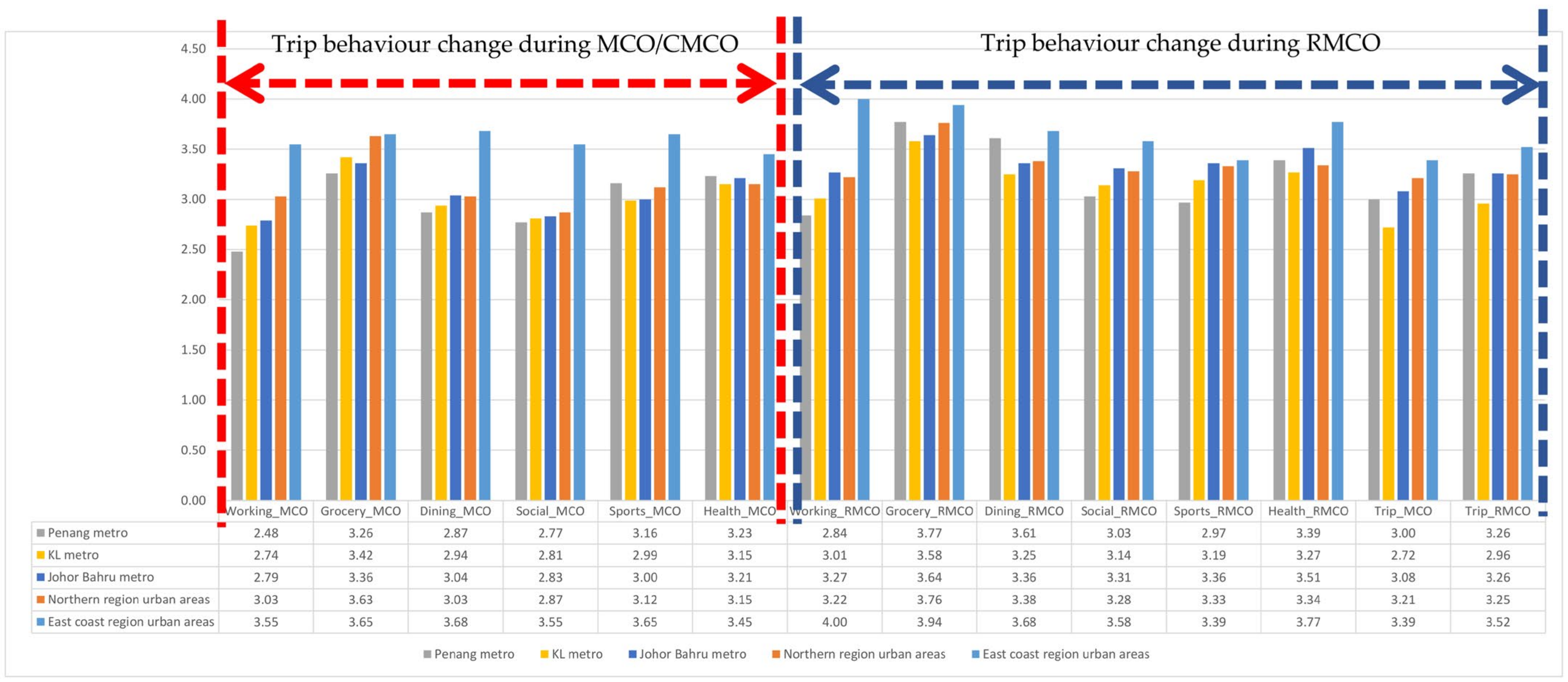
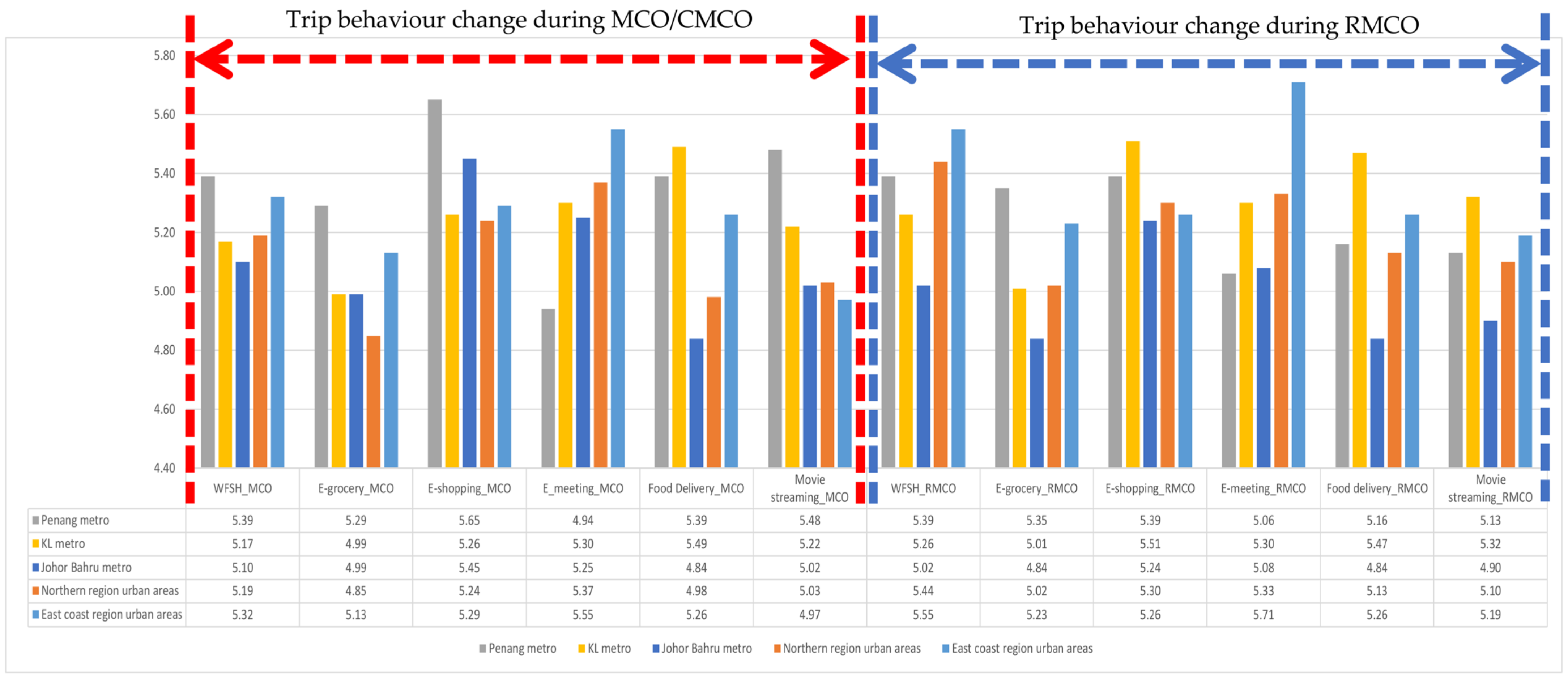
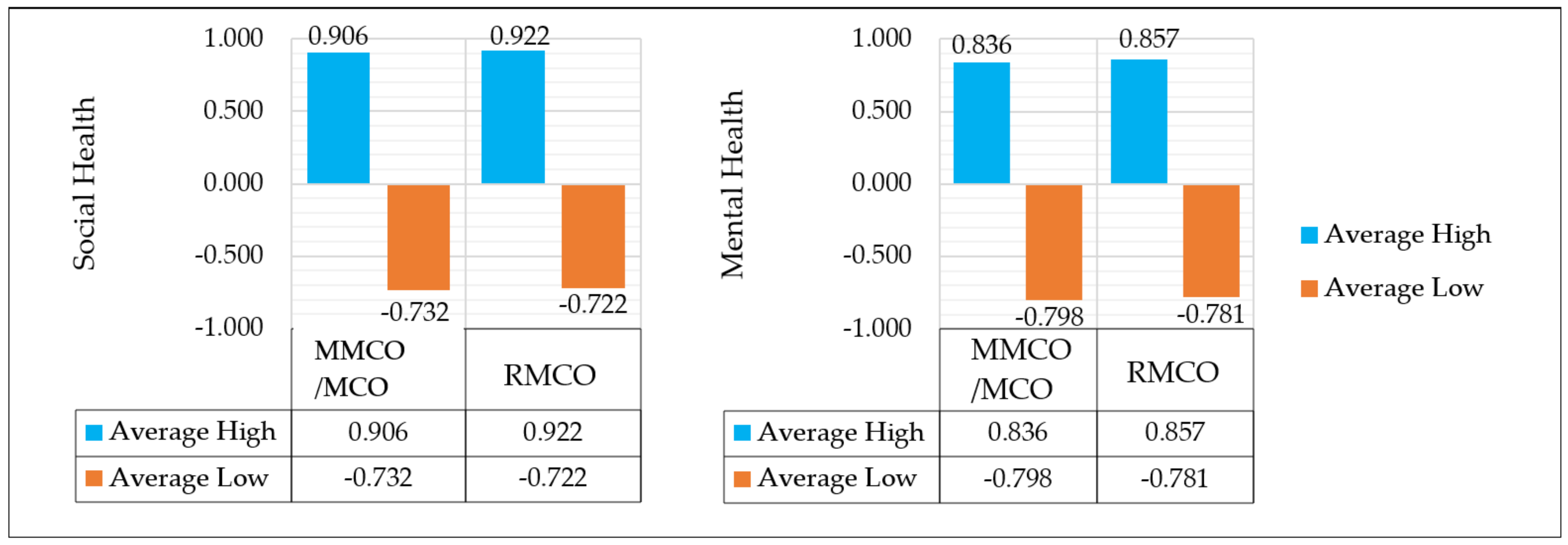

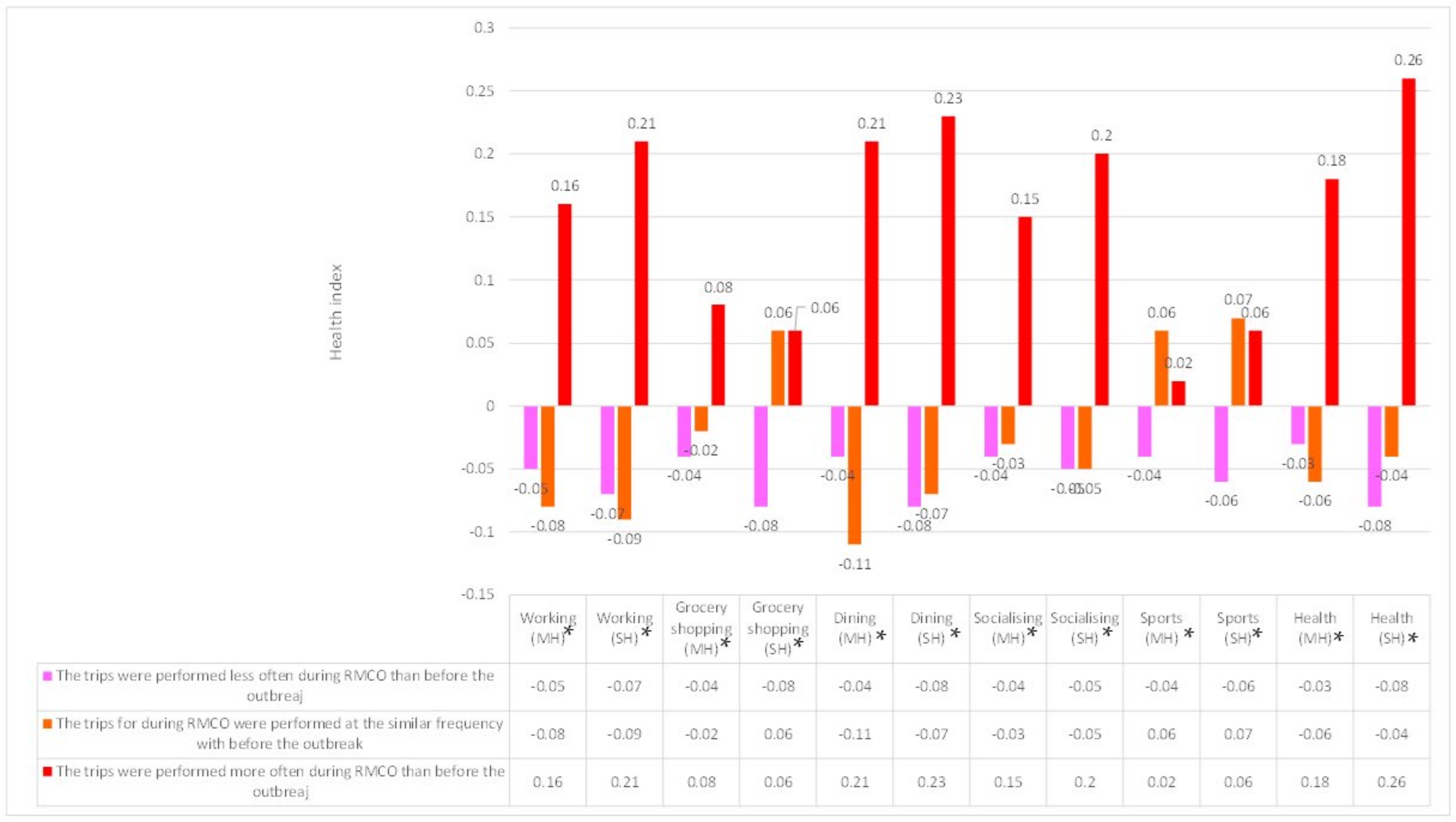
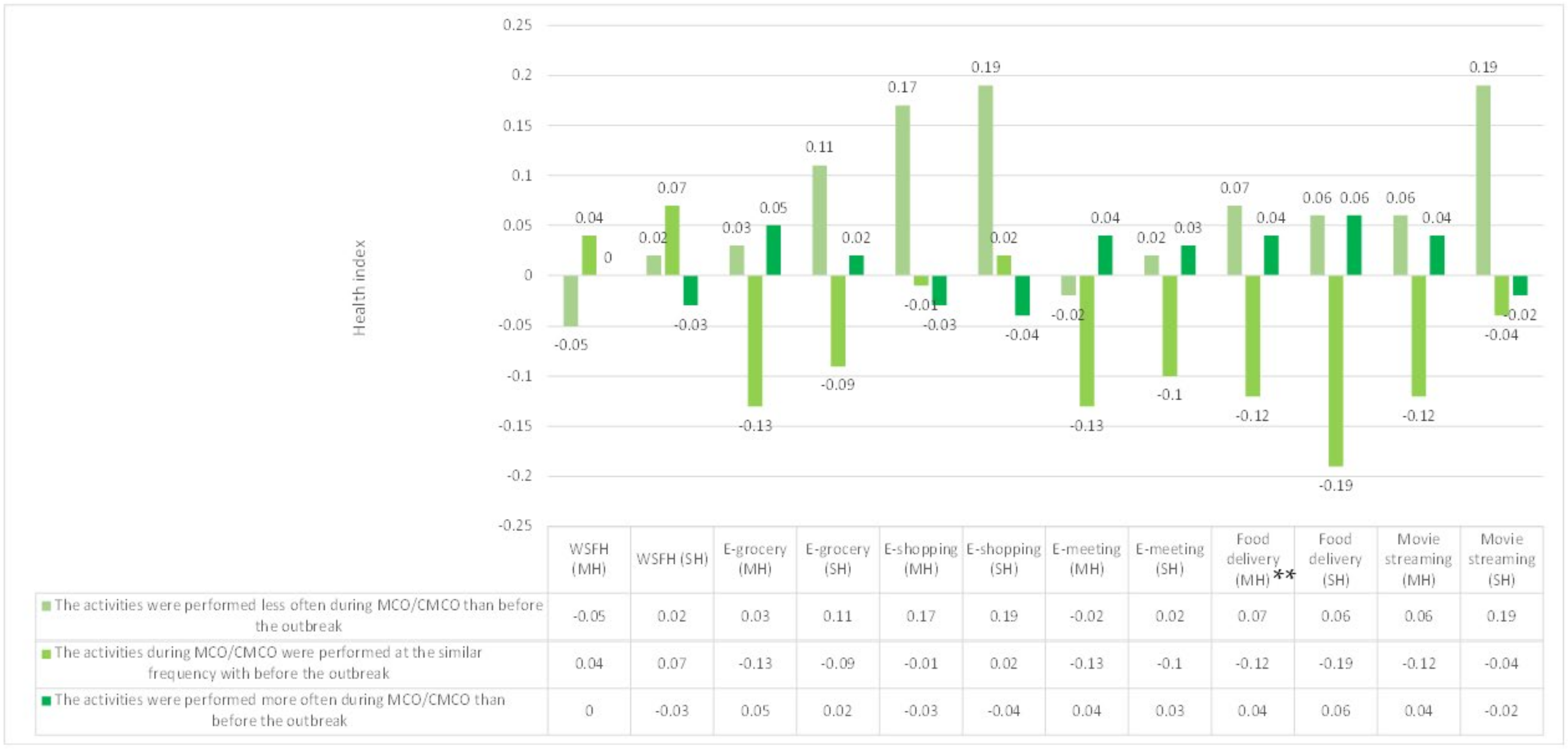
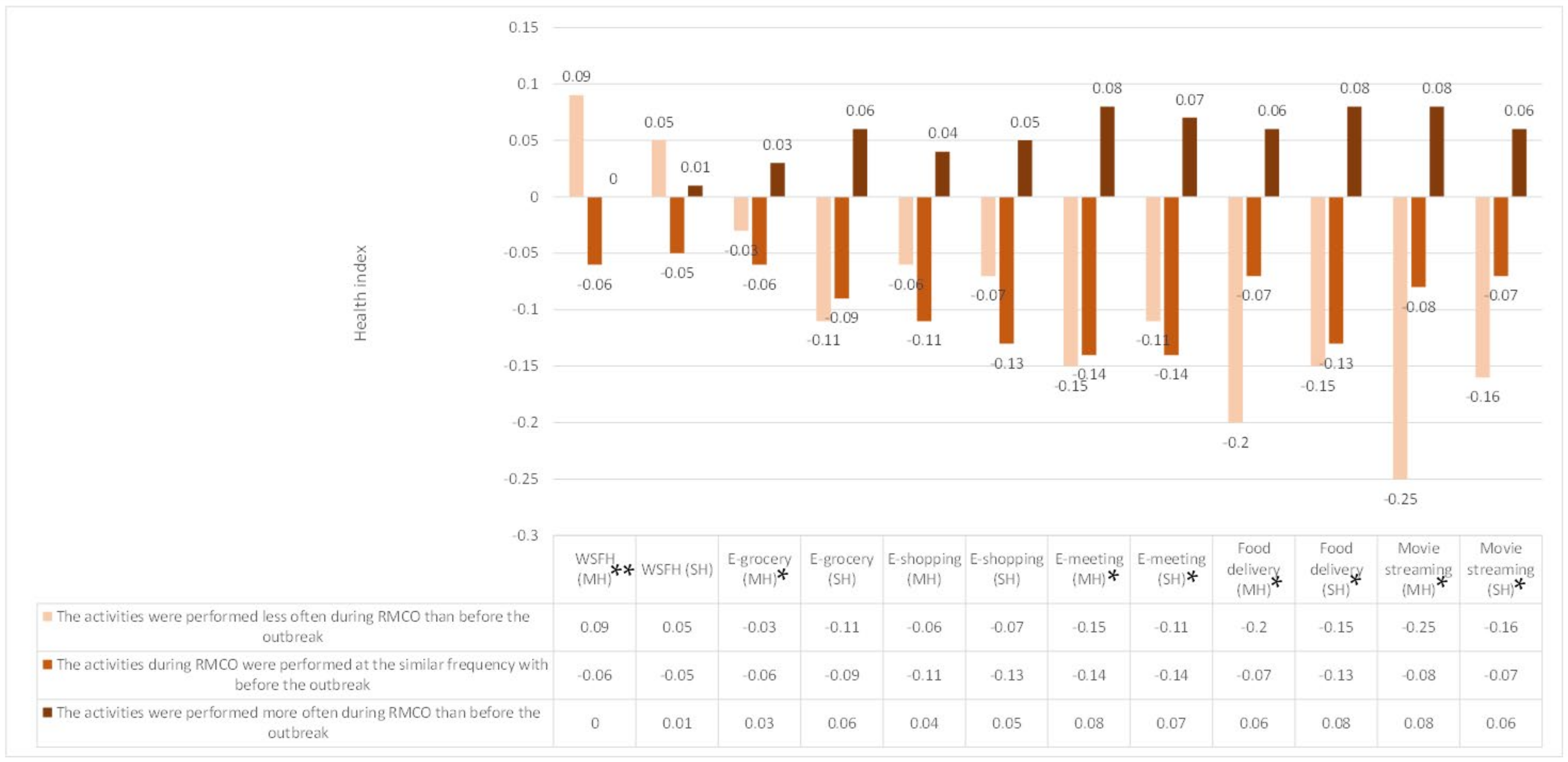
| Variables | Percentage | Mean (Standard Deviation) | |
|---|---|---|---|
| Gender | |||
| Male | 33.5% | ||
| Female | 66.4% | ||
| Age (years old) | 30.0 (8.1) | ||
| >25 years old | 40.4% | ||
| 26–45 years old | 55.0% | ||
| 46–60 years old | 3.9% | ||
| >60 | 0.7% | ||
| Education | |||
| High school or below | 6.6% | ||
| Diploma/Degree | 63.9% | ||
| Postgraduate | 29.4% | ||
| Occupation | |||
| Non-workers | 6.6% | ||
| Students | 30.6% | ||
| Workers | 62.7% | ||
| Number of households | 4.8 (2.0) | ||
| Single | 6.8% | ||
| Couple | 6.4% | ||
| 3–5 members in the household | 53.7% | ||
| >5 members in the household | 33.1% | ||
| Income | |||
| Low income (<MYR 3000) | 20.3% | ||
| Middle income (MYR 3000–10,000) | 54.0% | ||
| High income (>10,000) | 25.7% | ||
| Number of cars in the household | |||
| No car available | 5.5% | ||
| 1–2 cars | 66.0% | ||
| >2 cars | 28.5% | ||
| Number of motorcycles in the household | |||
| No motorcycle is available | 32.0% | ||
| 1–2 motorcycles | 56.4% | ||
| >2 | 11.6% | ||
| Residential location | |||
| KL metropolitan area | 33.6% | ||
| Penang metropolitan area | 7.8% | ||
| Johor Bahru metropolitan area | 23.3% | ||
| Metropolitan areas in the Northern area (or defined as Northern Region) | 27.6% | ||
| Metropolitan areas in the East Coastal area (or defined as East Coast Region) | 7.8% | ||
| Variables | MCO/CMCO | RMCO | |||
|---|---|---|---|---|---|
| On weekdays | Mean | Standard Deviation | Mean | Standard Deviation | |
| More trips for working | 2.9 | 1.9 | 3.2 * | 1.9 | |
| More trips for grocery shopping | 3.5 | 1.8 | 3.7 ** | 1.8 | |
| More trips for dining | 3.1 | 1.8 | 3.4 * | 1.7 | |
| More trips for socialising | 2.9 | 1.7 | 3.3 * | 1.7 | |
| More trips for sports | 3.1 | 1.7 | 3.3 | 1.7 | |
| More trips for health purposes | 3.2 | 1.5 | 3.4 * | 1.6 | |
| More total number of trips | 3.0 | 1.7 | 3.2 | 1.7 | |
| On weekends | |||||
| More trips for working | 3.2 | 1.8 | 3.2 | 1.7 | |
| More trips for grocery shopping | 3.3 | 1.7 | 3.5 ** | 1.7 | |
| More trips for dining | 3.1 | 1.7 | 3.3 * | 1.7 | |
| More trips for socialising | 3.0 | 1.7 | 3.3 * | 1.7 | |
| More trips for sports | 3.1 | 1.7 | 3.2 ** | 1.7 | |
| More trips for health purposes | 3.4 | 1.5 | 3.4 | 1.6 | |
| More total number of trips | 3.2 | 1.7 | 3.3 | 1.6 | |
| On weekdays | |||||
| More private vehicles | 3.8 | 2.0 | 3.8 | 1.9 | |
| More ridesharing | 3.5 | 1.7 | 3.6 | 1.6 | |
| More public transport | 3.2 | 1.6 | 3.3 | 1.5 | |
| More ride-sourcing | 3.4 | 1.6 | 3.5 | 1.6 | |
| More walking/cycling | 3.6 | 1.6 | 3.7 | 1.5 | |
| On weekends | |||||
| More private vehicles | 3.9 | 1.9 | 3.9 | 1.9 | |
| More ridesharing | 3.5 | 1.6 | 3.6 | 1.6 | |
| More public transport | 3.3 | 1.6 | 3.3 | 1.5 | |
| More ride-sourcing | 3.5 | 1.5 | 3.5 | 1.6 | |
| More walking/cycling | 3.6 | 1.5 | 3.7 | 1.6 | |
| Online activities | |||||
| More work/school from home | 5.2 | 1.8 | 5.3 | 1.7 | |
| More e-grocery shopping | 5.0 | 1.6 | 5.0 | 1.6 | |
| More e-shopping | 5.4 | 1.6 | 5.4 | 1.5 | |
| More e-meeting | 5.3 | 1.8 | 5.3 | 1.7 | |
| More food delivery using ride-sourcing | 5.2 | 1.7 | 5.2 | 1.6 | |
| More movie streaming | 5.1 | 1.7 | 5.2 | 1.6 | |
| More use of social media | 5.2 | 1.6 | 5.2 | 1.5 | |
| More use of computer | 5.3 | 1.6 | 5.3 | 1.5 | |
| More use of gadgets | 5.4 | 1.5 | 5.4 | 1.5 | |
| Observed Variables | Loading Factors | Latent Variables (Mean, Standard Deviation, Maximum and Minimum Value of Factor Scores) |
|---|---|---|
| Limitations of role functioning because of physical health (RP) | 0.436 | Social health/SH (0.00, 1.00, 1.79, −2.72) |
| Social functioning (SF) | 0.326 | |
| Limitations of role functioning because of emotional problems (RE) | 0.422 | |
| General health (GH) | 0.296 | Mental health/MH (0.00, 1.00, 1.88, −3.25) |
| Bodily pain (BP) | 0.254 | |
| Social functioning (SF) | 0.263 | |
| Vitality (VT) | 0.413 | |
| Mental health (MH) | 0.432 |
| Variables | MH | SH | ||||||
|---|---|---|---|---|---|---|---|---|
| Model 1 | Model 2 | Model 1 | Model 2 | |||||
| Coeff | T-Stat | Coeff | T-Stat | Coeff | T-Stat | Coeff | T-Stat | |
| Intercept | −0.324 | −1.589 | 0.448 | −2.067 | −0.0481 | −0.239 | 0.623 | 2.947 |
| RMCO | ||||||||
| MCO/CMCO | Ref | Ref | Ref | Ref | ||||
| Penang metro area | ||||||||
| Johor Bahru metro area | −0.120 | −3.026 | −0.045 | −1.823 | ||||
| Northern region urban areas | −0.071 | −1.775 | −0.044 | 1.779 | ||||
| East coastal region urban areas | 0.042 | 1.793 | −0.063 | −1.718 | −0.055 | −2.419 | ||
| KL metro area | Ref | Ref | Ref | Ref | Ref | Ref | Ref | Ref |
| Performing working trips more often on weekdays during the pandemic compared to before the pandemic | 0.144 | −2.342 | ||||||
| Performing grocery shopping trips more often on weekdays during the pandemic compared to before the pandemic | ||||||||
| Performing dining trips more often on weekdays during the pandemic compared to before the pandemic | 0.068 | 1.832 | ||||||
| Performing socialising trips more often on weekdays during the pandemic compared to before the pandemic | −0.105 | −2.451 | 0.077 | 1.835 | ||||
| Performing sports trips more often on weekdays during the pandemic compared to before the pandemic | ||||||||
| Performing health care trips more often on weekdays during the pandemic compared to before the pandemic | ||||||||
| Performing more trips per day on weekdays during the pandemic compared to before the pandemic | −0.163 | −2.367 | −0.081 | −1.950 | ||||
| Performing working trips more often on weekends during the pandemic compared to before the pandemic | 0.130 | 2.354 | 0.085 | 2.558 | ||||
| Performing grocery shopping trips more often on weekends during the pandemic compared to before the pandemic | 0.063 | 1.774 | −0.073 | −2.095 | ||||
| Performing dining trips more often on weekends during the pandemic compared to before the pandemic | 0.065 | 1.606 | ||||||
| Performing socialising trips more often on weekends during the pandemic compared to before the pandemic | −0.079 | −1.748 | 0.075 | 1.698 | ||||
| Performing sports trips more often on weekends during the pandemic compared to before the pandemic | 0.112 | 1.681 | ||||||
| Performing health care trips more often on weekends during the pandemic compared to before the pandemic | ||||||||
| Performing more trips per day on weekends during the pandemic compared to before the pandemic | ||||||||
| Performing work/study from home more often during the pandemic compared to before the pandemic | −0.113 | −2.168 | −0.083 | −1.691 | ||||
| Performing e-grocery shopping more often during the pandemic compared to before the pandemic | 0.096 | 1.818 | ||||||
| Performing e-shopping/e-commerce more often during the pandemic compared to before the pandemic | −0.159 | −2.775 | −0.126 | −2.222 | ||||
| Performing e-meetings for mandatory and leisure purposes more often during the pandemic compared to before the pandemic | 0.100 | 1.684 | 0.117 | 1.995 | ||||
| Performing food delivery using ride-sourcing more often during the pandemic compared to before the pandemic | −0.058 | −1.778 | 0.071 | 2.230 | ||||
| Performing movie streaming more often during the pandemic compared to before the pandemic | 0.085 | 1.759 | 0.074 | 2.434 | −0.050 | −1.670 | ||
| Using social media more often during the pandemic compared to before the pandemic | ||||||||
| Using computers more often during the pandemic compared to before the pandemic | ||||||||
| Using gadgets more often during the pandemic compared to before the pandemic | 0.139 | 2.254 | 0.095 | 2.513 | ||||
| Taking private vehicles more often on weekdays during the pandemic compared to before the pandemic | ||||||||
| Taking ridesharing more often on weekdays during the pandemic compared to before the pandemic | ||||||||
| Taking public transport more often on weekdays during the pandemic compared to before the pandemic | ||||||||
| Taking ride-sourcing more often on weekdays during the pandemic compared to before the pandemic | 0.066 | 1.751 | ||||||
| Taking walking and cycling more often on weekdays during the pandemic compared to before the pandemic | 0.057 | 1.654 | ||||||
| Taking private vehicles more often on weekends during the pandemic compared to before the pandemic | ||||||||
| Taking ridesharing more often on weekends during the pandemic compared to before the pandemic | 0.114 | 2.714 | ||||||
| Taking public transport more often on weekends during the pandemic compared to before the pandemic | −0.077 | −2.002 | ||||||
| Taking ride-sourcing more often on weekends during the pandemic compared to before the pandemic | −0.112 | −2.758 | ||||||
| Taking walking and cycling more often on weekends during the pandemic compared to before the pandemic | ||||||||
| Males | ||||||||
| Females | Ref | Ref | Ref | Ref | ||||
| Generation Z (<26 years old) | 0.158 | 2.745 | −0.159 | −2.825 | ||||
| Generation Y and X (26–55 years old) | 0.099 | 1.872 | −0.119 | −2.303 | ||||
| Baby boomers | Ref | Ref | Ref | Ref | ||||
| Part-time workers | 0.044 | 1.757 | −0.068 | −2.775 | ||||
| Full-time workers | 0.105 | 2.378 | −0.159 | −3.708 | ||||
| Students | −0.090 | −2.046 | ||||||
| Non-workers | Ref | Ref | Ref | Ref | ||||
| From high-income households | 0.075 | 2.709 | ||||||
| From middle-income households | ||||||||
| From low-income households | Ref | Ref | Ref | Ref | ||||
| Having more than 2 cars in the households | ||||||||
| Having 1–2 car/s in the households | ||||||||
| Having more than 2 motorcycles in the households | ||||||||
| Having 1–2 motorcycle/s in the households | ||||||||
| No car in the households | Ref | Ref | Ref | Ref | ||||
| Social health | 0.815 | 37.728 | ||||||
| Mental health | 0.780 | 37.728 | ||||||
| Mean | 0.000 | 0.000 | 0.000 | 0.000 | ||||
| SD | 0.999 | 0.999 | 0.999 | 0.999 | ||||
| Different lockdown phase error term (ui) | 0.000003 | 0.000002 | 0.000003 | 0.000002 | ||||
| 0.959 | 0.572 | 0.947 | 0.560 | |||||
| AIC | 2475.130 | 1606.535 | 2452.511 | 1568.171 | ||||
| BIC | 2675.310 | 1873.442 | 2652.691 | 1835.077 | ||||
| Log-likelihood | −1195.565 | −747.268 | −1184.256 | −728.085 | ||||
Publisher’s Note: MDPI stays neutral with regard to jurisdictional claims in published maps and institutional affiliations. |
© 2022 by the authors. Licensee MDPI, Basel, Switzerland. This article is an open access article distributed under the terms and conditions of the Creative Commons Attribution (CC BY) license (https://creativecommons.org/licenses/by/4.0/).
Share and Cite
Budiarto, A.; Abdi, N.S.; Dharmowijoyo, D.B.E.; Ahmad Termida, N.; Daniel, B.D.; Sukor, N.S.A.; Tanjung, L.E. Effects of Changes in Discretionary Trips and Online Activities on Social and Mental Health during Two Different Phases of the COVID-19 Pandemic in Malaysia. Sustainability 2022, 14, 13776. https://doi.org/10.3390/su142113776
Budiarto A, Abdi NS, Dharmowijoyo DBE, Ahmad Termida N, Daniel BD, Sukor NSA, Tanjung LE. Effects of Changes in Discretionary Trips and Online Activities on Social and Mental Health during Two Different Phases of the COVID-19 Pandemic in Malaysia. Sustainability. 2022; 14(21):13776. https://doi.org/10.3390/su142113776
Chicago/Turabian StyleBudiarto, Arif, Nur Shalin Abdi, Dimas Bayu Endrayana Dharmowijoyo, Nursitihazlin Ahmad Termida, Basil David Daniel, Nur Sabahiah Abdul Sukor, and Liza Evianti Tanjung. 2022. "Effects of Changes in Discretionary Trips and Online Activities on Social and Mental Health during Two Different Phases of the COVID-19 Pandemic in Malaysia" Sustainability 14, no. 21: 13776. https://doi.org/10.3390/su142113776






